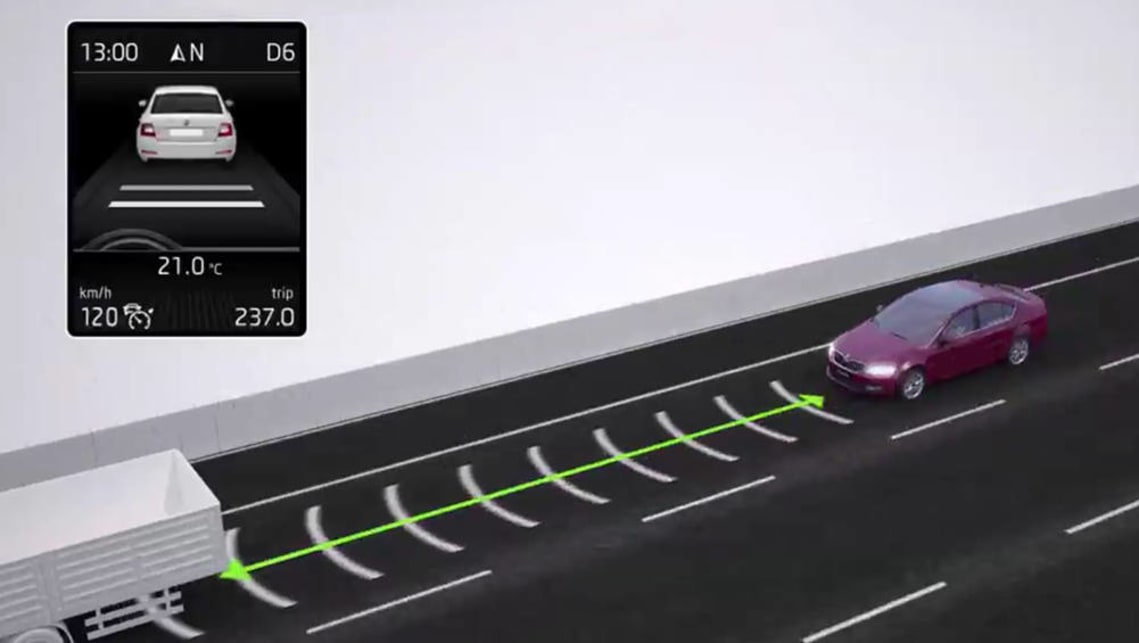Table Of Content

There continues to be plenty of confusion about self-driving or autonomous systems, what they are, and how they operate. However, the major difference between adaptive cruise control and a self-driving system is, ACC is simply a component of a driverless system. That is to say, ACC provides automatic braking and acceleration in a self-driving system that also includes steering, and sometimes automatic lane changing. “Most ACC systems can only be set to speeds above 20 mph but will slow the vehicle to speeds below that in stop-and-go traffic,” she says.
Algorithm for greener mobility: Gaining up to 8 percent more range in real-world driving - ZF Friedrichshafen AG
Algorithm for greener mobility: Gaining up to 8 percent more range in real-world driving.
Posted: Wed, 16 Aug 2023 07:00:00 GMT [source]
WHAT YOU NEED TO KNOW ABOUT ADAPTIVE CRUISE CONTROL
These systems are designed to help the driver, not to drive the car themselves while the driver dozes off or counts blue cars going the other way. All adaptive systems control the accelerator and brake, but some go beyond that. Some can do most of the steering for you on the highway (we call this lane-centering steering assist), but require you to keep a hand firmly on the wheel. Some can go even further than that by making automated lane changes once the driver signals and the car determines it’s safe to proceed.
Tesla Cuts Prices on Vehicles, Full Self-Driving Software
For example, Mercedes-Benz packages the radar behind the upper grille in the center and behind a solid plastic panel that has painted slats to simulate the look of the rest of the grille. For example, the Hyundai Elantra SEL ($22,795 with destination fee) offers its Smart Cruise Control with Stop and Go in its optional Convenience Package ($1,900). It also includes forward collision warning with automatic emergency braking, Junction-Turning Detection, navigation, wireless phone charging, heated front seats, and more. On the other hand, the same ACC system is standard for the $27,395 Elantra Limited. Although the state of autonomous driving today is Level 2, a few carmakers are on the precipice of Level 3. For example, Tesla’s Enhanced Autopilot, Ford’s BlueCruise, the Mercedes Drive Pilot, and General Motors’ Super Cruise bring the potential for Level 3.
ADAPTIVE CRUISE CONTROL CAN FOLLOW A VEHICLE TO A STOP
On most vehicles, Adaptive Cruise Control can follow a vehicle ahead to a stop. When the vehicle ahead starts moving again, you should check that it’s safe to proceed and then either press the accelerator pedal or RESUME button to continue driving. For very brief stops, Adaptive Cruise Control will automatically resume and follow the vehicle ahead. Just like normal cruise control, you can tap the brake to switch the system off or use the on/off button – usually located on the steering wheel. The ‘+’ and ‘-‘ buttons you use to adjust the speed with normal cruise control operate the same way with an adaptive cruise control system.
Buying a vehicle with this useful technology will help keep you safer on long drives. Always look at the safety features and get a car history report to learn what happened to the vehicle, whether it was in an accident, and how you can expect the car to hold up over time. Vehicle history reports can also help you know if the car was ever salvaged, if it experienced a flood, or has any open recalls on it, so you know what you're getting into before ever buying that vehicle. Standard cruise control and adaptive cruise control are helpful in long-haul driving scenarios, while the more advanced adaptive cruise control can alleviate stress in traffic. Forward collision alert and collision mitigation braking attempt to reduce the chances of drivers being involved in rear-end collisions, which are on the rise in the U.S. in part due to distracted driving from cellphone use. Tesla’s Autopilot system has attracted its share of controversy, and the name is a bit misleading considering that a human driver must be kept in the loop, but it’s still one of the most advanced systems of its kind.

The "Dynamic Laser Cruise Control System" used a laser-based sensor to estimate traffic distance. ACC systems fall into a spectrum of functionality, as the extensive computerization of the car has led to ACC systems that do much more than merely follow a car ahead at a fixed distance. Keith Barry has been an auto reporter at Consumer Reports since 2018. He focuses on safety, technology, and the environmental impact of cars.
What is adaptive cruise control and how does it work?
It can use radar, laser, binocular computer vision systems, a forward-aimed camera, or some combination of these technologies to track the traffic ahead of your vehicle. It senses when that traffic flow slows or stops, reacting to maintain the preset following distance. The cruise control tool will automatically slow you down if someone ahead of you slows down. When that person speeds back up, the cruise goes up to its set speed. This technology is powerful, and it's beginning to show up on more vehicles as standard features, too.
Adaptive Cruise Control: How Does It Work?
Not only does the system rely on an array of cameras, radar, and lidar, but Cadillac also mapped 200,000 miles of highway. Super Cruise also has a driver-facing camera, and will only work if a certain level of driver alertness is maintained. It maintains a set speed for your vehicle, like a conventional cruise control system, but it also adjusts the speed based on the traffic flow. Better systems can come you a full stop in heavy traffic and continue when congestion lightens.
Previously, he led home and appliance coverage at Reviewed; reported on cars for USA Today, Wired, and Car & Driver; and wrote for other publications as well. Keith earned a master’s degree in public health from Tufts University. Here’s a rundown of the terms the various carmakers use for ACC, even those that simply call it adaptive cruise control.
As stated earlier, some systems will bring your vehicle to a complete stop to match traffic flow. Even more intelligent systems can then accelerate as the traffic flow resumes. Simple to use, all you need to do is turn on the system in your vehicle, reach your desired cruising speed, and set it.
Volvo’s latest Pilot Assist II system doesn’t need to track a vehicle ahead, can a keep a car centered in its lane, and can operate at speeds up to 80 mph. Ever since the earliest days of adaptive cruise control, there's been a wide range of thought about which are the best type of sensors to use to detect traffic and the speeds of nearby vehicles. The earliest systems used laser or radar, and while both of those sensor types remain in use today, today's greater computing power and higher-resolution digital camera sensors have made camera-based ACC possible. Also known as active cruise control, autonomous cruise control, or intelligent cruise control, the adaptive cruise control system measures distance using a small radar in the car’s front end, a laser, or even stereoscopic cameras. It operates at all times of the day but loses some functionality in poor weather conditions. Level 2 – To qualify as Level 2, a vehicle must have at least two driver-assistance technologies.
You won't have to operate your brakes as often because your vehicle will maintain a safe distance from the other cars in front of you. Safety or driver assistance features are no substitute for the driver’s responsibility to operate the vehicle in a safe manner. The driver should remain attentive to traffic, surroundings and road conditions at all times. Visibility, weather and road conditions may affect feature performance. Read the vehicle’s Owner’s Manual for more important feature limitations and information. Much like using traditional cruise control, activating ACC is intentionally simple so that a driver can easily use it while keeping their eyes safely on the road.
Adaptive cruise control automatically controls the acceleration and braking of a vehicle. Technology, such as adaptive cruise control, can help reduce some of those issues and guard against accidents and other problems. This modern technology is only offered on some vehicles today, but it's worth getting for many buyers. Before you can decide if you want to pay for this technology, you should know what it is, how it works, and why it's beneficial to you. If your vehicle has this available feature, Adaptive Cruise Control† allows you to automatically follow a detected vehicle ahead at a driver-selected following gap. Cameras contribute with visual information, helping the system identify and track vehicles ahead.
Generally, the dedicated ACC button or switch is located on the steering wheel or control panel. Pressing or toggling this mechanism allows the driver to set their initial cruising speed. In some systems, drivers can also set their desired following distance. A radar and camera-based system, like Mercedes-Benz’s Distronic Plus system, uses both radars and cameras to scan the road ahead.
Every ACC system works slightly differently, says Kelly Funkhouser, manager for vehicle technology at CR. Laser-based systems do not detect and track vehicles in adverse weather conditions nor do they reliably track dirty (and therefore non-reflective) vehicles. Laser-based sensors must be exposed, the sensor (a fairly large black box) is typically found in the lower grille, offset to one side. In essence, not only did the 1999 S-Class introduce the driver-aid technology adaptive cruise control (ACC), but it also set the cornerstone of the foundation for self-driving vehicles. By the early 1990s, Japanese carmakers were adding a form of forward collision warning to their cruise control, but it was still up to the driver to react and apply the brakes. Not until Mercedes-Benz developed its Distronic cruise control did cruise control with self-braking make its first public appearance.
